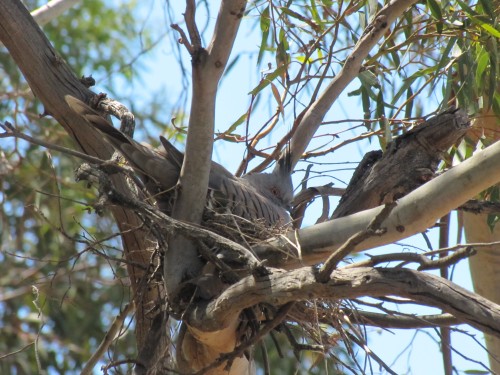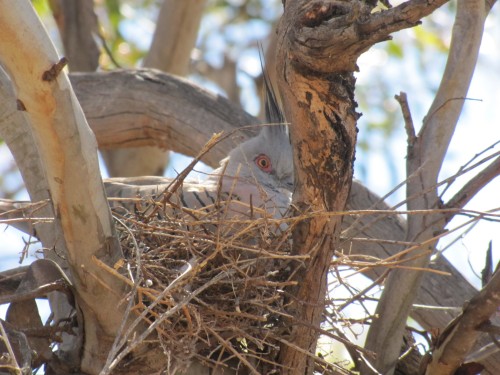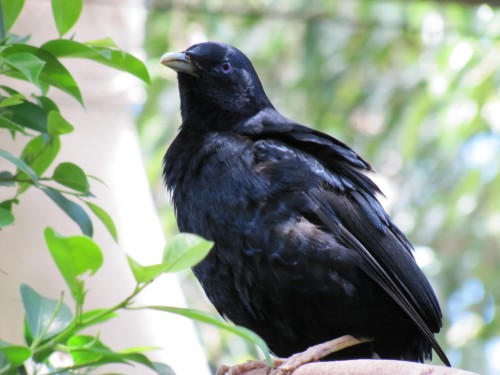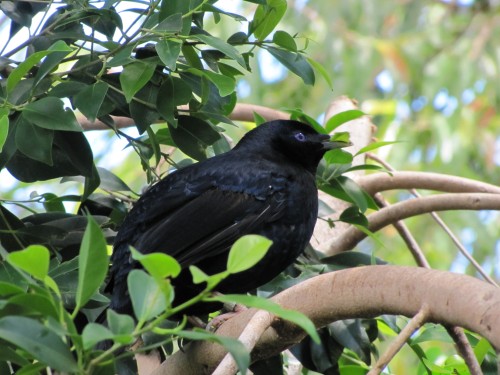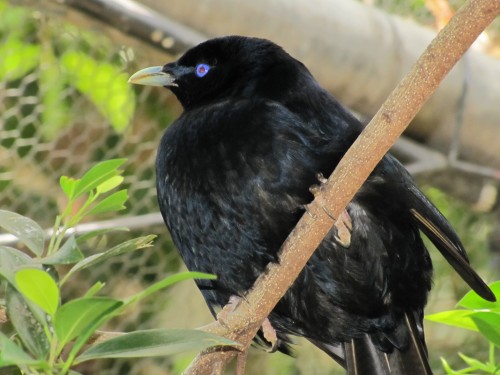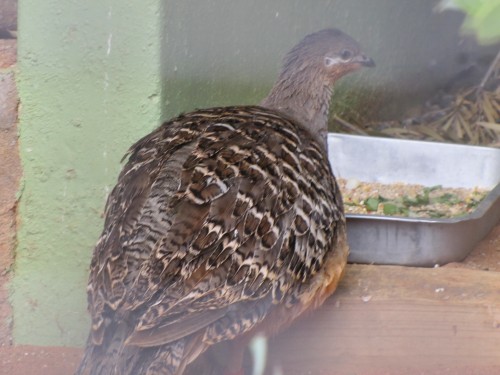Crested Pigeons nesting in our garden
On our return from a recent holiday in Sydney we were having lunch on the back veranda. I was watching a Crested Pigeon fussing about in a tree about twenty metres away. Next thing it settled down as if on a nest. I left my food – actually I think I was at the cuppa stage of the meal – and moved slowly and carefully towards the nest. I’d remembered to go inside to get my camera first.
Sure enough – the pigeon was sitting on a nest. Crested Pigeons are very common around Murray Bridge. At times I have counted up to 50 sitting perched on power lines, often in a row. It’s quite a spectacular sight, though it is not common to see so many at one location. Loose groups of 5 to 15 are quite common, however.
Crested Pigeons are what I call a resident breeding species, meaning, they are resident all the year and that they breed in our garden. The nest shown in today’s photos is quite a substantial nest for a pigeon. Most pigeons and doves are not fastidious or elaborate when it comes to nest building. They seem to think that a dozen or so flimsy sticks placed at random in the fork of any tree or bush will do as a home for their chicks. How the eggs don’t fall through some nests I’ve seen is amazing. Still, they seem to manage; there are a lot of them around!
My writing of this post was interrupted by the load of washing finishing, and I am the one in our household who usually does the washing. The pigeon’s nest is near the clothes line and the bird is sitting tight, even when we walk within a few metres of the nest. She must have eggs, I think. I will keep a watch on proceedings.
UPDATE: January 22nd: over the last week we have had a heatwave with five days over 42C with several over 45C (113F). This was followed by several days of wild wind which broke several branches off our trees. The nest is still there but appears to have been abandoned.
Satin Bowerbird, Adelaide Zoo
These photos were taken in a walk through aviary in the Adelaide Zoo, South Australia. Visiting the zoo with its excellent collection of birds is always an attraction for me because one can get up close to many species I’ve not seen in their natural environment – or only fleetingly seen at a distance. It’s very good for honing one’s photography skills too.
I’ve only seen a Satin Bowerbird in its natural habitat on a handful of occasions, the most recent being a few weeks ago in a garden in Bright, Victoria. It frequents rainforests, woodlands, scrubs, orchards, parks and gardens. This species is found along the coastal parts of eastern Australia, from southern Queensland through New South Wales and into Victoria. There is an isolated race in northern Queensland.
The female builds a stick nest in a tree near to the bower of the male. Like other bowerbird species the male builds an elaborately decorated bower of sticks on the ground to attract the female, usually including a vast collection of blue or yellow objects.
Malleefowl in the Adelaide Zoo
The Malleefowl, a turkey-sized mound building bird of the drier parts of Australia, is a widespread but uncommon bird living in the region where I live. It is primarily a ground dwelling bird, feeding mainly on seeds. The male makes a large 2 to 3 metre wide mound of sand and vegetation like leaves, grass, bark and so on which acts like a compost heap.
The rotting vegetation develops heat which incubates the eggs the female lays and buries in the mound. The male works the mound daily during the summer months, adding or removing soil to regulate the temperature in the egg chamber. Not surprisingly, this bird is also known as the Incubator Bird. In all my years of birding I have only seen about a dozen of this species, but amazingly, I saw 6 in a one hour period.
The bird in the photo above is a captive bird in the Adelaide Zoo.
Have the babies flown the nest?
We have a pair of Willie Wagtails who live in our garden. They often come very close to us as we work in the garden, especially when we are weeding or digging the garden beds. They are quite unafraid of us. Every year they build a nest somewhere near the house. Quite often they will even have a second brood of young ones.
This year I noticed them building a nest a few days before we went to Sydney for just over two weeks. I checked on our return and one of the adults was sitting on the nest; I didn’t know if there were eggs or chicks in the nest and didn’t want to disturb the parent bird. Now two weeks later and the nest is empty – in fact, it’s on the ground.
Enough time has elapsed for the eggs to have hatched and the young to have flown. Strange then that we haven’t seen the little ones begging to be fed. I suspect that the nest may have been raided by some form of predator: raven, magpie, currawong, falcon – even a stray cat that has been lurking in the vicinity.
All I can hope is that they decide to nest again – in a more secure location.
We have baby Willie Wagtails in a nest
I had suspected that our resident pair of Willie Wagtails have been nesting somewhere in our mallee scrub but hadn’t been able to locate the nest. They can be very sneaky and secretive about the whole affair.
Then a few days ago I was cleaning up in an area of the scrub not frequented all that often and I was attacked by the adults. Not that they actually hit or bit me; they just made it quite obvious by their scotching calls and close swooping over my head that I was not welcome.
Sure enough – three fluffy chicks were over filling a totally inadequate nest. The photo above shows their home almost bursting at the seams.
I took the photo a few weeks ago and the chicks have now fledged and are making their presence known around the garden, demanding food from a harried set of parents struggling to keep up with their insistent calling for food.
The next question is: will the parents nest again once this brood is off their hands… er… beaks and feeding themselves independently?
The photo of some fledged Willie Wagtails was taken a few years ago at the same location.
Further reading:
